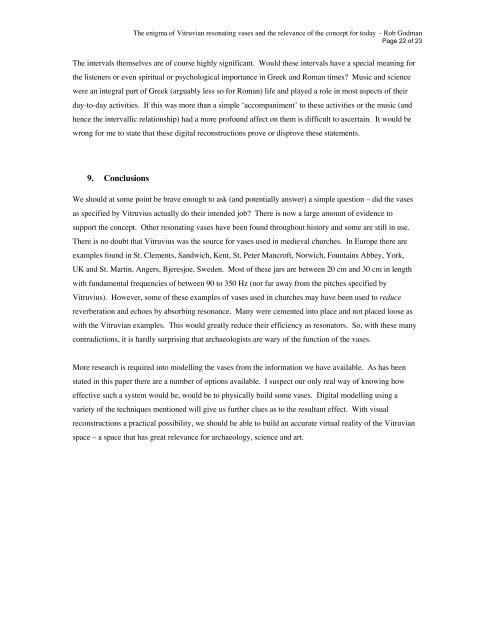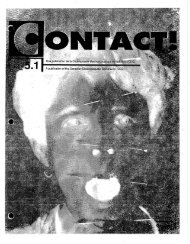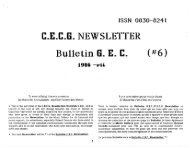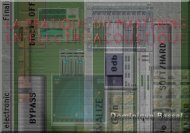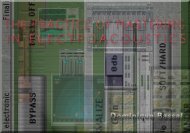The enigma of Vitruvian resonating vases and the relevance ... - CEC
The enigma of Vitruvian resonating vases and the relevance ... - CEC
The enigma of Vitruvian resonating vases and the relevance ... - CEC
You also want an ePaper? Increase the reach of your titles
YUMPU automatically turns print PDFs into web optimized ePapers that Google loves.
<strong>The</strong> <strong>enigma</strong> <strong>of</strong> <strong>Vitruvian</strong> <strong>resonating</strong> <strong>vases</strong> <strong>and</strong> <strong>the</strong> <strong>relevance</strong> <strong>of</strong> <strong>the</strong> concept for today - Rob Godman<br />
Page 22 <strong>of</strong> 23<br />
<strong>The</strong> intervals <strong>the</strong>mselves are <strong>of</strong> course highly significant. Would <strong>the</strong>se intervals have a special meaning for<br />
<strong>the</strong> listeners or even spiritual or psychological importance in Greek <strong>and</strong> Roman times? Music <strong>and</strong> science<br />
were an integral part <strong>of</strong> Greek (arguably less so for Roman) life <strong>and</strong> played a role in most aspects <strong>of</strong> <strong>the</strong>ir<br />
day-to-day activities. If this was more than a simple ‘accompaniment’ to <strong>the</strong>se activities or <strong>the</strong> music (<strong>and</strong><br />
hence <strong>the</strong> intervallic relationship) had a more pr<strong>of</strong>ound affect on <strong>the</strong>m is difficult to ascertain. It would be<br />
wrong for me to state that <strong>the</strong>se digital reconstructions prove or disprove <strong>the</strong>se statements.<br />
9. Conclusions<br />
We should at some point be brave enough to ask (<strong>and</strong> potentially answer) a simple question – did <strong>the</strong> <strong>vases</strong><br />
as specified by Vitruvius actually do <strong>the</strong>ir intended job? <strong>The</strong>re is now a large amount <strong>of</strong> evidence to<br />
support <strong>the</strong> concept. O<strong>the</strong>r <strong>resonating</strong> <strong>vases</strong> have been found throughout history <strong>and</strong> some are still in use.<br />
<strong>The</strong>re is no doubt that Vitruvius was <strong>the</strong> source for <strong>vases</strong> used in medieval churches. In Europe <strong>the</strong>re are<br />
examples found in St. Clements, S<strong>and</strong>wich, Kent, St. Peter Mancr<strong>of</strong>t, Norwich, Fountains Abbey, York,<br />
UK <strong>and</strong> St. Martin, Angers, Bjeresjoe, Sweden. Most <strong>of</strong> <strong>the</strong>se jars are between 20 cm <strong>and</strong> 30 cm in length<br />
with fundamental frequencies <strong>of</strong> between 90 to 350 Hz (nor far away from <strong>the</strong> pitches specified by<br />
Vitruvius). However, some <strong>of</strong> <strong>the</strong>se examples <strong>of</strong> <strong>vases</strong> used in churches may have been used to reduce<br />
reverberation <strong>and</strong> echoes by absorbing resonance. Many were cemented into place <strong>and</strong> not placed loose as<br />
with <strong>the</strong> <strong>Vitruvian</strong> examples. This would greatly reduce <strong>the</strong>ir efficiency as resonators. So, with <strong>the</strong>se many<br />
contradictions, it is hardly surprising that archaeologists are wary <strong>of</strong> <strong>the</strong> function <strong>of</strong> <strong>the</strong> <strong>vases</strong>.<br />
More research is required into modelling <strong>the</strong> <strong>vases</strong> from <strong>the</strong> information we have available. As has been<br />
stated in this paper <strong>the</strong>re are a number <strong>of</strong> options available. I suspect our only real way <strong>of</strong> knowing how<br />
effective such a system would be, would be to physically build some <strong>vases</strong>. Digital modelling using a<br />
variety <strong>of</strong> <strong>the</strong> techniques mentioned will give us fur<strong>the</strong>r clues as to <strong>the</strong> resultant effect. With visual<br />
reconstructions a practical possibility, we should be able to build an accurate virtual reality <strong>of</strong> <strong>the</strong> <strong>Vitruvian</strong><br />
space – a space that has great <strong>relevance</strong> for archaeology, science <strong>and</strong> art.


